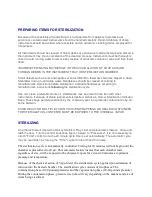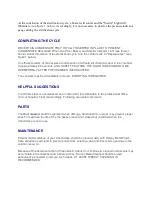
PREPARING ITEMS FOR STERILIZATION
Because of the possibility of transmitting micro-organisms from patients to professional
personnel, contaminated instruments should be handled carefully. Hand-Scrubbing of sharp
instruments should be avoided where possible and an ultrasonic cleaning device employed for
this purpose.
All Instruments should be cleaned of blood, debris or extraneous material before being placed in
the instrument tray. Upon completion of the cleaning process, instruments must be thoroughly
rinsed in cold running water to remove any residue of ultrasonic solution or soap and then towel
dried.
INCOMPLETE RINSING MAY RESULT IN THE ACCUMULATION OF SOAP ASH AND
FOREIGN DEBRIS IN THE INSTRUMENT TRAY OR STERILIZATION CHAMBER.
Small objects such as burs and needles or items difficult to towel dry should be dipped in Vapo-
Steril after rinsing to eliminate water. Handpieces should be cleaned according to
manufacturer's instructions before sterilization. Lubricate handpieces according to
manufacturer's instructions
following
the sterilization cycle.
Use only clean, preferably sterile oil. Handpieces may be placed in the tray with other
instruments. If storage of sterile instruments is desired, sterilize in Harvey Sterilization Indicator
Bags. These bags permit penetration by the chemical vapor, but preclude contamination by air-
borne bacterin.
AVOID HEAVY OR MULTIPLE TIGHTLY WOVEN WRAPPINGS OR SEALED CONTAINERS.
FOR STERILIZATION, CONTENTS MUST BE EXPOSED TO THE CHEMICAL VAPOR.
STERILIZING
Line the instrument tray with a Harvey Sterilizer Tray Liner and place items thereon. Close and
latch the door. Turn the control knob (see figure 1 below) to "Pressurize". It is not necessary tp
turn th "Time" control since the 20 minute cycle time is set automatically. The automatic cycle
may be overridden by turning the "Time" control to other than 20 minutes.
The sterilization cycle is automatically controlled. Timing for 20 minutes will not begin until the
chamber is pressurized to 20 psi. This automatic feature insures that each chamber load,
regardless of size, will be exposed to the chemical vapors for at least 20 minutes at optimum
pressure and temperature.
Because of the chemical action of Vapo-Steril, the sterilization cycle begins upon admission of
solution into the heated chamber. The sterilization cycle consists of two phases: The
condensation phase (0-20 pounds pressure) and the vaporization phase (20-40 pounds pressure).
During the condensation phase, pressure rise time will vary depending on the number and size of
items being sterilized.
Summary of Contents for CHEMICLAVE 5000
Page 4: ......







